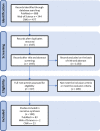Progress towards dog-mediated rabies elimination in PR China: a scoping review
- PMID: 37024944
- PMCID: PMC10077633
- DOI: 10.1186/s40249-023-01082-3
Progress towards dog-mediated rabies elimination in PR China: a scoping review
Abstract
Background: Rabies continues to be a serious threat to global public health endangering people's health and public health safety. In the People's Republic of China, multi-sectoral and comprehensive prevention and control strategies have aimed to extensively curb human rabies transmission. Here, we examine the current state of rabies infection in China, explore strategic interventions put in place in response to WHO's ambition of "Zero rabies deaths by 2030" and critically assess the constraints and feasibility of dog-mediated rabies elimination in China.
Methods: This study analyzed and evaluated the process towards dog-mediated rabies elimination in China from five perspectives: namely, human, dog, policy, challenge, and prospects. Evidence-based data on progress of dog-mediated rabies elimination in China was derived from a number of sources; a literature search was undertaken using PubMed, Web of Science and CNKI databases, distribution data for human rabies cases as derived from the Data-center of the China Public Health Science and policy and document data were obtained from official websites of the relevant China ministries and commissions.
Results: The incidence of human rabies cases in China have shown a downward trend year-on-year since 2007. Implementation of a government-led, multi-sectoral "One Health" approach to combating rabies has driven down the total number of rabies deaths nationwide to around 200 in 2020. The number of provincial-level administrative divisions (PLADs) reporting human cases of rabies has also decreased to 21 in 2020, 13 of which reported less than 10 cases. Furthermore, the number of outpatient visits seeking rabies post-exposure prophylaxis has risen dramatically over the past two decades, with demand being 15 times higher than it was initially. There remain however, significant gaps in rabies elimination outcomes across the different regions of China. To date the target of achieving a canine rabies vaccination rate of > 75% has not been met. The challenges of rabies immunization of dogs and dog management in underdeveloped cities and rural areas need to be addressed together with more effective animal surveillance and rabies risk from and too wildlife and livestock.
Conclusions: The Chinese government-led, multi-sectoral "One Health" approach to combating rabies and has made significant progress over the past decade. Development and adoption of more cost-effective One Health strategies can achieve more nationally beneficial rabies elimination outcomes. The ambitious target of "Zero rabies deaths by 2030" can be met through establishment of long-lasting herd immunity in dogs by means of dog mass vaccination campaigns, dog population management, epidemiological surveillance and the application of large-scale oral rabies vaccine to eliminate rabies in wild animals coupled with deployment of cost-effective human post-exposure prophylaxis, and community education.
Keywords: China; Dog; Elimination; Epidemics; Lyssavirus; Neglected; One Health; Rabies; Tropical; Underreporting.
© 2023. The Author(s).
Conflict of interest statement
The authors declare no conflict of interest.
Figures



References
-
- Genus: Lyssavirus | ICTV. https://ictv.global/report/chapter/rhabdoviridae/rhabdoviridae/lyssavirus. Accessed 17 Nov 2022.
-
- Baer GM. 1—the history of rabies. In: Jackson AC, Wunner WH, editors. Rabies. 2. Oxford: Academic Press; 2007. pp. 1–22.
Publication types
MeSH terms
Substances
Grants and funding
LinkOut - more resources
Full Text Sources
Medical
Research Materials
Miscellaneous

